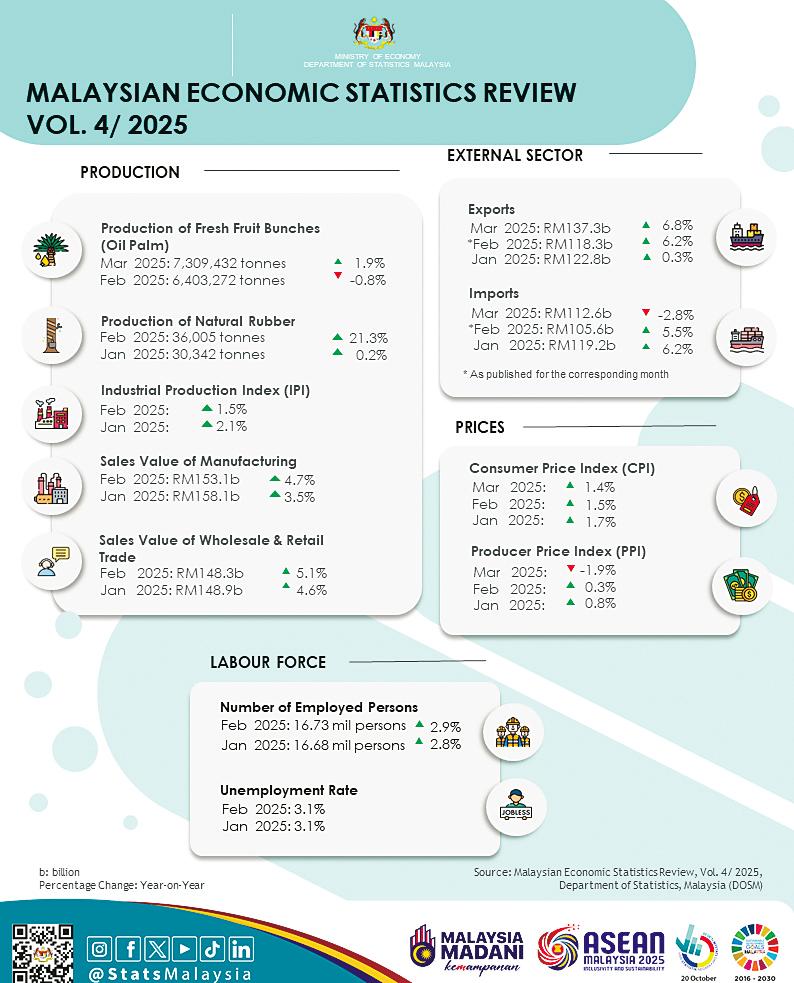PUTRAJAYA: Malaysia’s advance GDP estimates point to a steady growth of 4.4% in the first quarter of 2025, although this marks a moderation from the 5% recorded in the previous quarter, said Chief Statistician Malaysia, Datuk Seri Dr Mohd Uzir Mahidin.
The growth, he added continued to be underpinned by the services, manufacturing and construction sectors, while the mining and quarrying sector remained on a declining trajectory.
However, on a quarter-on-quarter basis, he said the economy contracted by 3.7%, against a 2.7% expansion in the fourth quarter of 2024.
Continuing its upward trajectory, Malaysia’s industrial production demonstrated moderate growth in February 2025. The Industrial Production Index (IPI) rose by 1.5%, largely driven by a notable 4.8% expansion in the manufacturing sector.
This positive performance outweighed declines in other sectors, notably mining and electricity, which recorded contractions of 8.9% and 2.8% respectively. These contrasting outcomes underscore the uneven nature of industrial production in the country.
When comparing month-on-month figures, the IPI experienced a drop of 6.8% in February, a sharp decline compared to a marginal decrease of 0.4% recorded in January 2025.
Looking at a broader perspective, Malaysia’s wholesale & retail trade sector achieved RM148.3 billion of sales in February 2025, reflecting a growth of 5.1% compared to the same month in the previous year.
This increase was largely driven by strong performances in retail trade which grew by 5.9% and wholesale trade at 5.3%. In a similar trend, the volume index also experienced a year-on-year rise of 3.9%, with wholesale trade rising 4.9% and retail trade growing 4.3%. However, when compared to January 2025, the sector saw a slight decline of 0.4% in overall sales, primarily due to decreases in both wholesale trade (-1.9%) and retail trade (-1.5%). This indicates a slowdown in consumer activity month-on-month, despite the positive year-on-year performance.
In a climate of stable economic conditions, Malaysia’s inflation rate eased to 1.5% in February 2025, down from 1.7% in January. This moderation was primarily driven by slower price increases in key categories such as housing, water, electricity, gas & other fuels, which saw a growth of 2.3%, and recreation, sport & culture which increased by 1.5%.
Malaysia’s trade sector continued to demonstrate steady growth in early 2025, driven by strong performances in both exports and imports. In February 2025, Malaysia’s total trade increased by 5.9% year-on-year, reaching RM223.9 billion. This growth was largely fuelled by a 6.2% rise in exports, which amounted to RM118.3 billion, alongside a 5.5% increase in imports, totalling RM105.6 billion. As a result, the trade surplus saw a significant boost, rising by 12.2% to reach RM12.6 billion.
“The country’s labour market continued to show strength, with the number of employed persons rising by 2.9% year-on-year to reach 16.73 million in February 2025. This growth led to an increase in the employment-to-population ratio, which climbed to 68.5%, up from 68.2% in the same period last year. The labour force also expanded by 2.6%, reaching a total of 17.27 million, supported by a slight increase in the labour force participation rate which rose to 70.7%. Additionally, the number of unemployed persons decreased by 4.3%, falling to 532.8 thousand, which contributed to an unemployment rate of 3.1%,” said Mohd Uzir.









